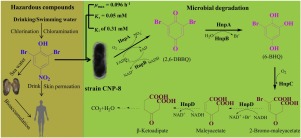Journal of Hazardous Materials ( IF 12.2 ) Pub Date : 2018-08-22 , DOI: 10.1016/j.jhazmat.2018.08.063 Jun Min , Weiwei Chen , Xiaoke Hu

|
Compound 2,6-dibromo-4-nitrophenol (2,6-DBNP) with high cytotoxicity and genotoxicity has been recently identified as an emerging brominated disinfection by-product during chloramination and chlorination of water, and its environmental fate is of great concern. To date, the biodegradation process of 2,6-DBNP is unknown. Herein, Cupriavidus sp. strain CNP-8 was reported to be able to utilize 2,6-DBNP as a sole source of carbon, nitrogen and energy. It degraded 2,6-DBNP in concentrations up to 0.7 mM, and the degradation of 2,6-DBNP conformed to Haldane inhibition model with μmax of 0.096 h-1, Ks of 0.05 mM and Ki of 0.31 mM. Comparative transcriptome and real-time quantitative PCR analyses suggested that the hnp gene cluster was likely responsible for 2,6-DBNP catabolism. Three Hnp proteins were purified and functionally verified. HnpA, a FADH2-dependent monooxygenase, was found to catalyze the sequential denitration and debromination of 2,6-DBNP to 6-bromohydroxyquinol (6-BHQ) in the presence of the flavin reductase HnpB. Gene knockout and complementation revealed that hnpA is essential for strain CNP-8 to utiluze 2,6-DBNP. HnpC, a 6-BHQ 1,2-dioxygenase was proposed to catalyze the ring-cleavage of 6-BHQ during 2,6-DBNP catabolism. These results fill a gap in the understanding of the microbial degradation process and mechanism of 2,6-DBNP.
中文翻译:

Cupriavidus sp。对2,6-二溴-4-硝基苯酚的生物降解。CNP-8菌株:动力学,途径,遗传和生化特性
具有高细胞毒性和基因毒性的化合物2,6-二溴-4-硝基苯酚(2,6-DBNP)最近被鉴定为水氯化和氯化过程中一种新兴的溴化消毒副产物,其环境命运备受关注。迄今为止,尚不知道2,6-DBNP的生物降解过程。在此,Cupriavidus sp.。据报道,菌株CNP-8能够利用2,6-DBNP作为碳,氮和能量的唯一来源。它降解2,6- DBNP在浓度高达0.7毫米,和2,6- DBNP的降解符合霍尔丹抑制模型与μ最大的0.096ħ -1,ķ小号的0.05 mM和ķ我0.31毫米 比较转录组和实时定量PCR分析表明,hnp基因簇可能是2,6-DBNP分解代谢的原因。纯化了三种Hnp蛋白并进行了功能验证。发现在黄素还原酶HnpB存在下,HnpA(一种依赖FADH 2的单加氧酶)催化将2,6-DBNP依次脱硝和脱溴为6-溴羟基喹诺醇(6-BHQ)。基因敲除和互补揭示,hnpA对于菌株CNP-8利用2,6-DBNP是必不可少的。HnpC,6-BHQ 1,2-双加氧酶被提出来催化2,6-DBNP分解代谢过程中6-BHQ的环裂解。这些结果填补了对2,6-DBNP微生物降解过程和机理的理解的空白。






























 京公网安备 11010802027423号
京公网安备 11010802027423号